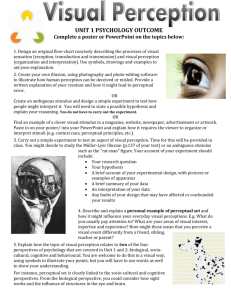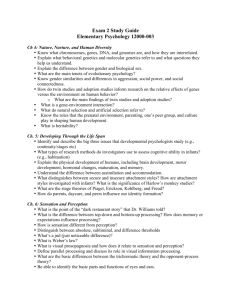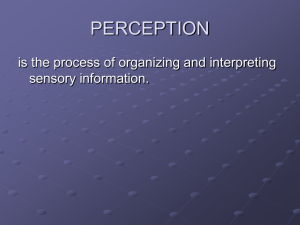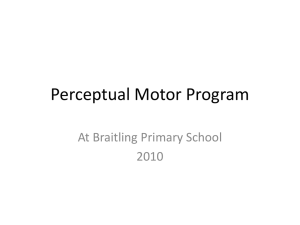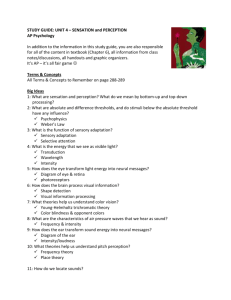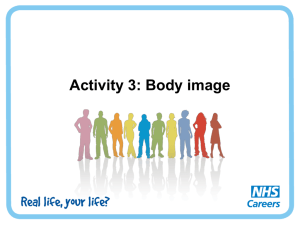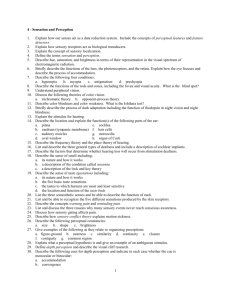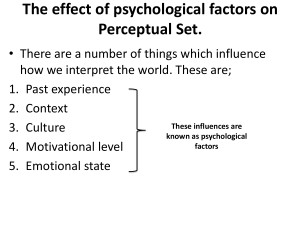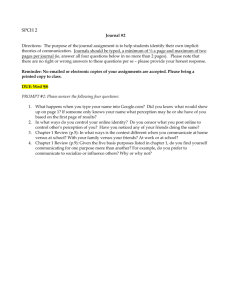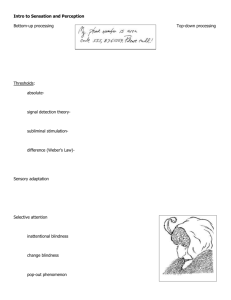PERCEPTUAL ASPECTS OF BEHAVIOR CHAPTER
advertisement
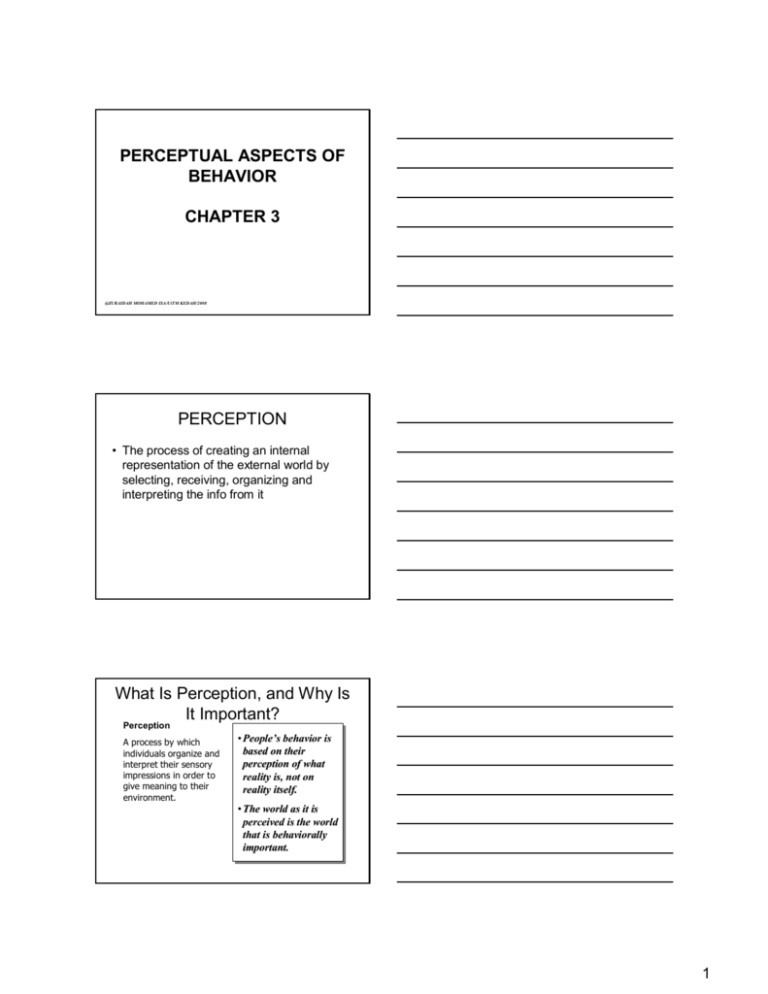
PERCEPTUAL ASPECTS OF BEHAVIOR CHAPTER 3 @ZURAIDAH MOHAMED ISA/UiTM KEDAH/2008 PERCEPTION • The process of creating an internal representation of the external world by selecting, receiving, organizing and interpreting the info from it What Is Perception, and Why Is It Important? Perception A process by which individuals organize and interpret their sensory impressions in order to give meaning to their environment. • People’ People’s behavior is based on their perception of what reality is, not on reality itself. • The world as it is perceived is the world that is behaviorally important. 1 Factors That Influence Perception E X H I B I T 5–1 TARGET CHARACTERISTICS • Target is the person, object, place or thing where the perception is made on. • The characteristics are: – Motion action, movement, signal. – Intensity forceful of feeling or things. – Novelty new, unusual. – Sound melody, things that can be heard. – Size how small or big of something. – Background conditions that existed before or something seen or heard behind of other thing. (cont’d) • Example: “A red flash on nurse station console receives attention because: – It is bright (intensity) – It is flashing (motion) – it is a rare event (novelty) 2 PERCEIVER CHARACTERISTICS • It is the person who is making the perception on the target. • The characteristics are: – Attitudes Ali likes small class so that he can ask questions, but Ahmad prefer anonymity of a large class. – Motives unsatisfied needs encourage a person to fulfill it. – Interest engineer looks things from technical pt of view compared to doctors. – Past experience things or events related to oneself. – Expectations expect to see what we want to see. ORGANIZING PERCEPTUAL DATA • Figure and Ground – refers to the tendency to be able to distinguish a central object from its surroundings • Set – is the tendency to respond to a situation in term of prior information acquired rather than what actually exists • Gestalt – is the tendency to avoid the discomfort of unorganized information by assigning to it overall meaning • Attribution – is the tendency to try to understand behavior of a person or events by interpreting them as caused by certain environmental factors OPTICAL ILLUSION 3 OPTICAL ILLUSION OPTICAL ILLUSION OPTICAL ILLUSION 4 OPTICAL ILLUSIONS 5 OPTICAL ILLUSION PERCEPTUAL DISTORTION • • • • • Stereotypes Halo effects Selective perception Projection Expectancy Frequently Used Shortcuts in Judging Others Selective Perception People selectively interpret what they see on the basis of their interests, background, experience, and attitudes. 6 PERCEPTUAL DISTORTIONS 1. Selective Perception – People selectively interpret what they see on basis of their interest, background, experience & attitudes. – E.g. some employees may be reprimanded (object/disapprove) by their boss for doing something that done by another employee and goes unnoticed. – This happen because people take in bits & pieces, & that bits & pieces are selectively chosen according to people’s interest, background, experiences & attitudes. PERCEPTUAL DISTORTIONS Selective Perception – People selectively interpret what they see on basis of their interest, background, experience & attitudes. – E.g. some employees may be reprimanded (object/disapprove) by their boss for doing something that done by another employee and goes unnoticed. – This happen because people take in bits & pieces, & that bits & pieces are selectively chosen according to people’s interest, background, experiences & attitudes. Frequently Used Shortcuts in Judging Others Halo Effect Drawing a general impression about an individual on the basis of a single characteristic Contrast Effects Evaluation of a person’s characteristics that are affected by comparisons with other people recently encountered who rank higher or lower on the same characteristics. 7 PERCEPTUAL DISTORTIONS 2. Halo Effect – One’s general impression of a person usually based on one’s prominent (something that easily be seen) characteristics, biases one’s perception pf other characteristics of that person. – E.g. if we meet a client who speaks in a friendly manner, we tend to infer a host of other favorable qualities about that client. – It is most likely occur when concrete info abt a target is missing or we have insufficient info abt the target. Thus, perceiver tend to use his/her general impression of the target to fill in the missing info. PERCEPTUAL DISTORTIONS 2. Halo Effect – One’s general impression of a person usually based on one’s prominent (something that easily be seen) characteristics, biases one’s perception pf other characteristics of that person. – E.g. if we meet a client who speaks in a friendly manner, we tend to infer a host of other favorable qualities about that client. – It is most likely occur when concrete info abt a target is missing or we have insufficient info abt the target. Thus, perceiver tend to use his/her general impression of the target to fill in the missing info. Frequently Used Shortcuts in Judging Others Projection Stereotyping Attributing one’s own characteristics to other people. Judging someone on the basis of one’s perception of the group to which that person belongs. 8 PERCEPTUAL DISTORTIONS 3. Projection Bias – It is when one tend to believe that other people hold the same beliefs & attitudes that one does. – E.g. if we want a challenging task & responsibility, we might think other people want or feel the same. – Projection bias is usually a defense mechanism to protect our self-esteem. E.g. if we break a rule, projection bias could justify our claim that “everyone breaks it too”. PERCEPTUAL DISTORTIONS 4. Stereotyping – A process of assigning traits to people based on their membership to a social category. – In other words, stereotype defines people by the demographic & organizational groups to which people belong to. – Stereotypes are easy to confirm because they include abstract personality traits that is supported by ambiguous behaviors. – But, it does not accurately describe every person in the social categories & stereotyped perceiver often ignore or misinterpret info that is inconsistent with the stereotype. PERCEPTUAL DISTORTIONS 4. Stereotyping – A process of assigning traits to people based on their membership to a social category. – In other words, stereotype defines people by the demographic & organizational groups to which people belong to. – Stereotypes are easy to confirm because they include abstract personality traits that is supported by ambiguous behaviors. – But, it does not accurately describe every person in the social categories & stereotyped perceiver often ignore or misinterpret info that is inconsistent with the stereotype. 9 PERCEPTUAL DISTORTIONS 3. Projection Bias – It is when one tend to believe that other people hold the same beliefs & attitudes that one does. – E.g. if we want a challenging task & responsibility, we might think other people want or feel the same. – Projection bias is usually a defense mechanism to protect our self-esteem. E.g. if we break a rule, projection bias could justify our claim that “everyone breaks it too”. MGT 321 ORGANIZATIONAL BEHAVIOR MANAGING THE PERCEPTION PROCESS • Have a high level of self-awareness • Seek information from various sources to confirm or disconfirm personal impressions of a decision situation • Be empathetic – that is, able to see a situation as it is perceived by other people • Influence the perceptions of other people when they are drawing incorrect or incomplete impressions of events in the work setting • Avoid common perceptual distortions that bias our views of people and situations • Avoid inappropriate attributions 10
